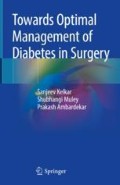Abstract
It is important to understand the insulin physiology, to comprehend in full the changes that occur in insulin deficiency state, and to facilitate the attempts to bring up the insulin levels to an effective state. In particular the differences in the metabolism between the portal insulin levels and the pharmacodynamics of the exogenously administered insulin should also be understood. In the same section, we will also describe some nonmetabolic actions of insulin underscoring the significance of insulin. Unless these actions and the scope of insulin physiology are precisely understood, the insulin and diabetes management will become a mechanistic unintelligent centered only on glucose control. Sadly this is the state of care in this area across the subcontinent and possibly other less developed countries as well.
Access this chapter
Tax calculation will be finalised at checkout
Purchases are for personal use only
Notes
- 1.
In normal persons as well as those with diabetes, the quantum, duration, and the peak of insulin response are less, when stimulated by intravenous glucose infusion compared to oral ingestion. Intravenous glucose stimulation does not invoke the action of enteroinsular axis as no food enters the stomach. In addition to it, there is believed to be a cephalic phase in food intake, which strengthens the enteroinsular axis.
- 2.
This is a commonly met situation in routine clinical practice as well. In newly diagnosed type 2 diabetes, the blood glucose can often be as high as 400 mg/dL. Yet the symptom profile is mild. Hence it is unnecessary to be alarmed by it. Simple measures like significant diet control and primary medication with oral drugs cause a quick reversal of glucotoxicity, and the blood glucose falls rapidly often with small quantities of drugs. It can then be brought under control with little intensification of treatment.
- 3.
In the initial stages of newly detected diabetes with high levels of glucose, fasting generally above 250 mg, it is a recommended practice to start the patient on insulin for a few weeks. This gives beta cells rest and replenishes its contents and can respond to glucose challenges of the newly detected diabetes better, offsetting the need for insulin. The results of this intervention could be remarkable.
References
Joslin EP. Joslin’s textbook of diabetes mellitus. 14th ed. Lippincott, Williams and Wilkins, USA 2005, Indian Edition
UKPDS. The Lancet. 2000.
Pickup, Williams. Textbook of diabetes. Oxford: Blackwell Publication; 1992.
Zoungas S, Patel A, Chalmers J, et al. Severe hypoglycemia and risks of vascular events and death. N Engl J Med. 2010;363:1410–8. https://doi.org/10.1056/NEJMoa1003795.
Hsu P-F, Sung S-H, Cheng H-M, et al. Association of clinical symptomatic hypoglycemia with cardiovascular events and total mortality in type 2 diabetes: a nationwide population based study. Diabetes Care. 2013;36:894–900. https://doi.org/10.2337/dc12-0916.
Gitt AK, Bramlage P, Binz C, et al. Hypoglycaemia is more frequent in type 2 diabetic patients with co-morbid vascular disease: an analysis of the DiaRegis registry. Eur J Prev Cardiol. 2012;19:765–72. https://doi.org/10.1177/1741826711411104.
Dunaif A, Graf M. Insulin administration alters gonadal steroid metabolism independent of changes in gonadotropin secretion in insulin-resistant women with the polycystic ovary syndrome. J Clin Investig. 1989;83(1):23–9. https://doi.org/10.1172/JCI113864.
Baron AD, Steinberg HO, Chaker H, Leaming R, Johnson A, Brechtel G. Insulin-mediated skeletal muscle vasodilation contributes to both insulin sensitivity and responsiveness in lean humans. J Clin Invest. 1995;96:786–92. https://doi.org/10.1172/JCI118124.
King GL, Johnson SM. Receptor-mediated transport of insulin across endothelial cells. Science. 1985;227:1583–6.
Langouche L, Vanhorebeek I, Vlasselaers D, et al. Intensive insulin therapy protects the endothelium of critically ill patients. J Clin Invest. 2005;115:2277–86.
Groeneveld ABJ, Beishuizen A, Visser FC. Insulin: a wonder drug in the critically ill? Crit Care. 2002;6:102–5.
McNulty PH, Pfau S, Deckelbaum LI. Effect of plasma insulin level on myocardial blood flow and its mechanism of action. Am J Cardiol. 2000;85:161–5.
Dandona P, Aljada A, Mohanty P, et al. Insulin inhibits intranuclear nuclear factor kappaB and stimulates IkappaB in mononuclear cells in obese subjects: evidence for an anti-inflammatory effect. J Clin Endocrinol Metab. 2001;86:3257–65.
Ferrannini E, Galvan AQ, Gastaldelli S, et al. Insulin: new roles for an ancient hormone. Eur J Clin Investig. 1999;29:842–52.
Das UN. Is insulin an endogenous cardioprotector? Crit Care. 2002;6:389–93.
Parsonage WA, Hetmanski D, Cowley AJ. Beneficial haemodynamic effects of insulin in chronic heart failure. Heart. 2001;85:508–13.
Levy J, Malaisse WJ. The stimulus-secretion coupling of glucose induced insulin release. XVII. Effects of sulfonylurea and diazoxide on insular biosynthetic activity. Biochem Pharmacol. 1975;24:235–9.
Author information
Authors and Affiliations
Rights and permissions
Copyright information
© 2019 Springer Nature Singapore Pte Ltd.
About this chapter
Cite this chapter
Kelkar, S., Muley, S., Ambardekar, P. (2019). Physiology of Insulin. In: Towards Optimal Management of Diabetes in Surgery. Springer, Singapore. https://doi.org/10.1007/978-981-13-7705-1_10
Download citation
DOI: https://doi.org/10.1007/978-981-13-7705-1_10
Published:
Publisher Name: Springer, Singapore
Print ISBN: 978-981-13-7704-4
Online ISBN: 978-981-13-7705-1
eBook Packages: MedicineMedicine (R0)

